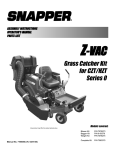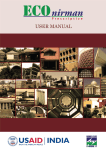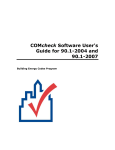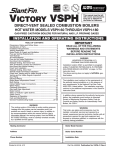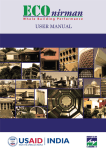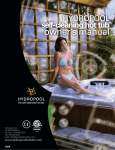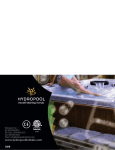Download Elastilon EST325P Installation Guide
Transcript
Product Manual Elastilon – The Revolutionary Self Adhesive Hardwood Flooring Installation System For technical information, please visit our website www.elastilonusa.com or contact us at 1-877-526-9663 or email us at [email protected] . Version 1.1 Elastilon Product Manual Table of Contents: Product Knowledge --------------------------------------------------------- 2 o o o o o o What Is Elastilon and how does it work? Features & Benefits Elastilon Simple Facts Warranty Information Installation has never been easier Questions and Answers Installation Tips - Before You Begin ------------------------------------ 15 Board Replacement Instructions ----------------------------------------- 17 How to become certified on Elastilon ----------------------------------- 21 For technical information, please visit our website www.elastilonusa.com or contact us at 1-877-526-9663 or email us at [email protected] . ~1~ Elastilon Product Manual Product Knowledge What Is Elastilon and how does it work? What is it? 1. Elastilon is a revolutionary Self Adhesive Installation System used in the installation of solid and engineered hardwood floors in any room including the basement. Floors are installed directly onto the Elastilon adhesive surface over just about any sub-surface including directly over concrete. 2. A totally new, installation system which makes the use of nails, nailing guns, messy glues and their spreaders, along with compressors and hoses completely unnecessary during the installation process. A utility knife is all that is needed to install Elastilon. How does it work? 1. Elastilon uses a permanently elastic cross-linked, closed-cell polyethylene construction combined with a nylon reinforced adhesive top layer that provides a strong continuous bond with the flooring above it. 2. Forms a solid inseparable floor that when installed properly, reduces gapping, warping, buckling or separation yet provides excellent thermal and acoustic properties. Features & Benefits Elastilon Strong 1. Turns a concrete slab into a hardwood floor in no time at all – from 50% to 70% faster than glue down and other traditional methods especially over concrete surfaces. Ideal installation method for condos and apartments. 2. Can be used for solid and engineered woods above and below grade including 3/4in solids. In all below-grade applications, always add an approved 6 mil polyethylene film vapor barrier before laying the Elastilon. For concrete floors that are on-grade or above-grade, if the moisture parameters are higher then the recommended levels or the moisture levels cannot be determined, a 6-mil polyethylene film vapor barrier must be installed. 3. Can be installed over any flat, clean stable surface excluding carpets. ~2~ Elastilon Product Manual 4. Ideal for those hardwood species that have moderate to high expansion/contraction characteristics including species that include maple & exotics such as bamboo. 5. Closed cell foam pad (50kg/m³) provides cushion for superior comfort and reduced impact noise. Up to an IIC 62 rating in use with ¾” hardwoods over a 6” concrete flooring system. 6. Easy peel off system allows for quick installations. Only tools you need are a utility knife! No messy glues to clean off the finished floor, tools or yourself. No compressors, hoses, power cords to move around. Simple, quick and easy! 7. Open time concerns which can play a roll in gluing are completely eliminated. – Unlimited open time. Once installed it can we walked on immediately. Baseboards and furniture can be installed immediately allowing for same day completions of installations. No restrictions for other work crews. 8. Can be used in residential and commercial applications. In many installations, the low profile aspect of Elastilon means no need to cut doors and minimal loss of head room.. 9. Suitable for use with under floor heating systems. 10. Elastilon seals the underside of the floor board reducing cupping. In all below-grade applications, always add an approved 6 mil polyethylene film vapor barrier before laying the Elastilon. For concrete floors that are on-grade or above-grade, if the moisture parameters are higher then the recommended levels or the moisture levels cannot be determined, a 6-mil polyethylene film vapor barrier must be installed. 11. Free of volatile materials and odor free. 12. Light weight and easy to transport to and from the jobsite. 8lbs compared to over 60lbs for a typical adhesive pail. 13. Long shelf life. Unused product can be used at a later date with no waste. 14. Easily repairable during and after the installation. 15. Elastilon strong comes with a Limited 70 year warranty. 16. Protected by a World Wide Patent. ~3~ Elastilon Product Manual Elastilon Simple Facts Strong Thickness – 3mm (.12 in) – Single Sided Adhesive Roll length – 10m (32.81 ft) Roll Width -- 1m (3.281 ft) Coverage per roll – 10m² (107.64 sq ft) Foam Density – 50kg/ m³ IIC 62 STC 54 (in combination with 3/4” flooring and Elastilon Strong) Warranty Information Elastilon Guarantees the glue layers used on all different Elastilon Systems will maintain its quality and strength, for at least 70 years after production. Elastilon guarantees that the elasticity of all Elastilon systems will maintain its quality for at least 70 years after production. Please review our complete warranty details available from http://elastilonusa.com/warranty.php or contact Elastilonusa directly at 1-877-526-9663. ~4~ Elastilon Product Manual Installation has never been easier Clean floor completely. In all below-grade applications, always add an approved 6 mil polyethylene film vapor barrier before laying the Elastilon. For concrete floors that are on-grade or above-grade, if the moisture parameters are higher then the allowed levels or the moisture levels cannot be determined, a 6-mil polyethylene film vapor barrier must be installed. Roll out Elastilon next to one another, with protective foil on top, perpendicular to the orientation of the wood flooring. Do not overlap the rolls. You will need to create a starter strip at the start of each row (where you will start to build your floor) and when you come to the end of a roll. There are two methods available: First time users: peel back the white vinyl protective foil the width of 2 ½ planks and cut off the Elastilon material below it (leaving the white protective foil). This protective foil is the starter strip which now should be positioned up against the wall where you intend to start laying the floor. The extra Elastilon that was cut off can be used at a later point in the installation or on a future installation. Simply place a leftover piece of the white protective foil over the exposed adhesive until it is ready to be used. After your first installation: use the white vinyl protective foil that was removed from a previous installation. With the Elastilon rolled out, peel and fold back the white vinyl protective foil the width of 2 ½ planks along the wall you will be starting at. (Do not cut the Elastilon or the foil)The adhesive layer will be exposed. Fold a piece of the extra white vinyl protective foil in half and place it onto the exposed adhesive layer with the crease facing the starting wall. Be sure that the temporary folded strip extends onto the original peeled back section. This temporary fold is now the starter strip where you will begin to build your floor. Place an expansion spacer of at least 5/8” (16 mm) at the start of the row and remember to maintain this gap on all other stationary walls and objects. With the white protective foil starter strip now folded back over the Elastilon, begin assembling the first two rows of flooring over this folded back strip from side wall to side wall. Be sure that the undersides of the flooring boards are clean and free of any debris. The end joints should be staggered as per manufacturer’s guidelines and for optimum performance a small amount of white carpenters glue (PVA) needs to be applied to all end joints / small joints. Be sure to clean any glue residue before it dries. ~5~ Elastilon Product Manual When the first two rows are in position, apply forward pressure to the two rows so that the joint between them is seamless; simply pull the white protective starter strip out from under the board to the edge of the flooring being careful not to expose the adhesive face. If this occurs, just tuck the protective foil back under the edge of the already installed floor board. Finally, if you are happy with the look of the floor, apply pressure to the top of the flooring to secure it firmly to the Elastilon. . It is permissible to use blue painters tape to keep board alignment as you continue to build the floor on the release film. At this time you can use a chalk or laser line to determine how straight your installed floor is. The floor can still be adjusted at this point to ensure that it is square to the room After the first few rows are installed cleanly, you can lay up multiple rows of flooring. Be sure to tap each board tightly together and to apply forward pressure as you pull the white protective foil from under the flooring. Continue to press down on the installed floor as you lay the floor wall to wall. It is recommended to put weight on the floor (as easy as walking over it), to help the floor adhere to the Elastilon evenly. Remember that Elastilon is a free floating installation membrane and should never be fastened to the floor below it or kept from moving freely. ~6~ Elastilon Product Manual Questions and Answers Is Elastilon user friendly? Elastilon installs 50 to 70% faster than traditional glue down and other hardwood flooring installations. It requires no messy glues and their specialized spreaders, no heavy compressors and their attachments and no nailing guns. A roll of Elastilon weighs considerably less then glue down adhesive pails or compressors and requires only a sharp knife for a perfect installation. For the end user, it does not release odors and has no VOCs. Finally, the floor can be walked on immediately after the installation. Where can Elastilon be used? Elastilon can be used over any structurally sound subfloor or just about any existing flooring material. Lay it right over any wood, concrete, vinyl tile or sheet, ceramic, or any other FLAT stable material. Be sure to follow the parameters in regards to maximum flatness in all cases. Do not install over any type of carpeting. Elastilon can be used in both residential and commercial applications. Is a moisture barrier needed under Elastilon? When installing hardwood flooring over concrete, the slab must be at least 60 days old and the moisture content cannot exceed 3lbs./1000 sf under a Calcium Chloride test. The moisture content of the concrete floor must not exceed 3.9%. Wood subfloors must not exceed 13% of moisture content and the difference between the subfloor and the flooring material must not exceed 4%. In all below-grade applications, always add an approved 6 mil polyethylene film vapor barrier before laying the Elastilon. For concrete floors that are on-grade or abovegrade, if the moisture parameters are higher then the recommended levels or the moisture levels cannot be determined, a 6-mil polyethylene film vapor barrier must be installed. All joints of the vapor barrier need to be overlapped by at least 8 “(20cm) and sealed with a moisture resistant tape. Allow the vapor barrier to run up the walls 3-4” (8-9cm). The excess can be trimmed once the installation is complete. It is always the best practice to cover any and all concrete surfaces with an approved vapor barrier prior to the installation of Elastilon. ~7~ Elastilon Product Manual Can Elastilon be installed over radiant heat? Use of an approved wood flooring water or electrical radiant subfloor heating system is approved when installed either within or above the concrete/wood subfloor. The heating system should be run 3 to 4 days prior to the installation at a reduced temperature of 64F (18c). Two days after the installation is complete, the temperature of the system may be raised gradually over a one week period to its desired operating temperature. Please note that the surface temperature of flooring should never exceed 81F (27C). Adding humidification may be necessary to maintain humidity levels at required levels. Always follow the flooring manufacturers’ recommendations when it comes to radiant heat. What about the room conditions? Floor must be even with a maximum tolerance of 1/8” over 6 ft or 3/16” over a 10 ft radius. (2mm per 2.5 meter). It must be clean and structurally sound, free of debris and any other loose material. Wood subfloors must be stable and securely fastened to supporting joists. Be sure to nail or screw any areas that are loose or squeak. Sand, scrap or grind any raised edges and level any low spots with the appropriate leveling compound (concrete floors included) As wood is a natural product, it is important to recognize that hardwood floors will be affected by the levels of humidity and temperature within a room. The climate conditions in the room need to be maintained prior (at least 14 days), during and after the installation. The installation site must have a consistent room temperature of 60-80F (16-27C) and humidity level between 4065% maximum. Permanent air conditioning and heating systems need to be operational at all times. Care must be taken with wood stoves and electric heat which tend to create very dry conditions. The use of dehumidifier or humidifier depending on the situation may be necessary to maintain desired results. For complete details on how to deal with wood floors and the environment, please refer to the NWFA publications (No. A100 - Water and Wood / No. C200 -Problems, Causes and Cures). Is acclimation of the flooring necessary prior to the installation? We strongly recommend that you follow the wood manufacturers / industry standard recommendations in regards to acclimatization for the wood flooring. Depending on the species of wood, a wood moisture test may be necessary to ensure a safe moisture content level is achieved prior to installation. Typically these levels are between the 6 to 9 percent range but can vary by region. For complete details on wood floors and the environment, please refer to the NWFA publication #. A100 - Water and Wood. All wood products are affected by environmental conditions, especially prefinished materials. Acclimate the new flooring in the areas to be installed to normal lived in conditions while in the boxes. If products are protected in plastic, open the ends of the boxes along with the plastic wrap. The goal is to reach an ~8~ Elastilon Product Manual equilibrium or moisture balance between the new flooring with its surroundings before the installation. Very dry or humid regions usually require extended conditioning. Recommended acclimation levels maintained even after the installation will minimize board movement, excessive squeaks and gaps. Proper jobsite conditions such acclimation, moisture testing of the subfloor, the room and the new flooring are important components for a successful installation. This is the responsibility of those overseeing the project. Why does it recommend that a small amount of glue be used on the end joints? Depending on the quality of the milling, hardwood flooring has a tendency to move up or down especially on the end joints. Glue should be placed on the inside of the groove joint on the small ends of all floor boards. (eg. the 3 ½” width) Can a floor be repaired when installed with Elastilon? It is possible to remove an installed floor board for only a brief period after it has been installed on Elastilon. Slowly pull up the board from the Elastilon taking particular care not to damage the adhesive layer. You may need to force some of the loose release foil under the piece of wood you are removing to help separate it from the Elastilon glue surface. A removed board can then be reinstalled correctly. Once the adhesive has set (approximately 20 minutes), the only means to remove a board is to cut out the piece in question and replace it by gluing the four sides of a new board back in place. Be sure to place a piece of Elastilon underneath the new board so as to ensure a level surface with the rest of the floor. Our board replacement instructions are available from www.elastilonusa.com or by contacting Elastilonusa directly at 1-877-526-9663. What makes Elastilon different than other installations? Remember that this is a free floating floor that should never be fastened directly to the floor beneath it and an expansion space of at least 5/8” (16mm) must be maintained around all walls and stationary objects. Expansion joints will also need to be installed in doorways, long hallways, and larger areas more than 33 ft (10m) in length following the direction of the small width (eg. 3 ½” width) of the floor boards. Additional Expansion joints are not necessary in the direction of the long length of the floor boards with expanses longer than 33 ft (10m) permitted (all small end joints must be glued). Please note expansion joints must be covered with the appropriate molding. Where necessary cut the door casings/jambs to allow the wood flooring to slide underneath. Baseboards should never be fastened directly to the floor itself and may need to be raised to allow the flooring to slide underneath. If not raised, a small molding can be added to conceal the expansion gap after the installation is complete. Once the floor has been completely installed, remove the expansion spacers and trim any excess poly to the floor level. To cover the expansion gaps, install / reinstall all baseboards and add appropriate moldings as needed. How do I work around small or tight areas such as door jambs while trying to remove the release paper? In areas where there is limited space or where the release foil will be difficult to work with, the release foil may be removed around the area and the exposed Elastilon glue surface misted with water to allow for the easy ~9~ Elastilon Product Manual movement of the floor. A spray bottle set to the finest mist setting should be used. Once the water evaporates there will be a strong bond between the wood and the Elastilon. Be sure to apply pressure to the top of the board to set in place. This process can be used to work around door jambs or any other obstacles. Removal of the release foil should be limited to only small areas no larger than 1 sq ft (300mm²) What happens when I get to a stair edge when installing over concrete? The best solution for Elastilon and stair edges is the use of an overlap stair nosing. In all cases, it is important to maintain the proper expansion spacing on both the stair edge and the opposite wall. Please note the overlap stair nosing should be affixed to only the subfloor material below and not to the Elastilon. The Elastilon must be allowed to move freely. Can I use Elastilon with all wood types? The Elastilon Strong self adhesive installation membrane has been engineered to work with many species of wood flooring. It is important that the manufacturers / industry recommendations be followed before, during and prior to the installation in regards to both room conditions and site preparation. The Elastilon instructions must be closely adhered to as well. It is also important to visually inspect each piece of wood flooring before being installed. As with any other type of installation method, Elastilon cannot compensate for flooring that is severely bowed warped, cupped, milled incorrectly or damaged prior to an installation. However, most boards may be used if the defective section is cut and removed with the remainder of the board used as a start or end piece, used in a closet, in a low traffic or used in a concealed portion of the room. Please note that the use of mechanical fastening systems such as straps should never be used to force boards together. Pressure from a rubber mallet and the use of blue painters tape to keep boards tight is permissible. During the racking (building) of the floor on top of the Elastilon protective release strip, flooring that is not severely bowed can be installed as long as it can still be inserted into the T&G of all the boards surrounding it. This will pull the board straight and allow full contact on the Elastilon membrane. Be sure to place a small amount of carpenters glue on all four sides of the affected board for a concern free installation. ~ 10 ~ Elastilon Product Manual What are examples of flooring not recommended for use with Elastilon? It is not recommended to use Elastilon with odd lots, cabin grade, and rustic grades of hardwood flooring. If unsure please contact ElastilonUSA directly at 1-877-526-9663. How does Elastilon work with thinner boards? Although the instructions are common to the installation of Elastilon with all hardwood floors, particular attention must be given to the following when installing thinner boards. ie, ½”(12.5mm), 3/8”(10mm) and 5/16”(8mm) All end joints must be glued throughout the installation. The sub-floor must be flat to within .08 inch over 8 ft (2mm over 2.5m) Expansion room must be maintained around all walls and obstacles. Transition moldings need be placed at all doorways and hall entrances and areas greater than 30ft in width or length. Extremely heavy furniture can cause noticeable deflection with thinner boards. Try to distribute weight over a greater area. Each board should be carefully inspected prior to the installation. Boards should be straight and flat without bowing, warping or cupping prior to installation. Proper acclimation of the wood floor prior to the installation Maintaining the proper room conditions prior, during and after the installation. Is floor noise common? Deflection may cause a minimal amount of friction or "floor noise". Note that normal floor noise will vary from one installation type to the next depending on sub-floor type, sub-floor deflection, species, milling and type of flooring material, relative humidity and the amount of topside pressure applied to the flooring material. For these reasons, "Floor Noise" is not considered a defect. Can I join the Elastilon rolls with tape to seal all the edges? The Elastilon rolls should never be attached or joined together on the long length of the rolls. This will hamper the elastic nature of the product and could cause floor failure. It is recommended that the rolls of Elastilon be loose fitted side by side. It is allowable to join the short ends (3 ft side) of the rolls with tape. What is the Shelf life of Elastilon? Shelf life of the product is at least 2 years when stored as stated on the technical data sheets: @ 21°C, 50% relative humidity, no direct sunlight/ strong artificial light. ~ 11 ~ Elastilon Product Manual What are the Technical Specifications of Elastilon Strong? Material Properties: P.E. Foam Quality: Chemically cross-linked Polyethylene Density: 50 kg/m³ Tensile strength (longitudal): 0,60 N/mm² Elongation (longitudal): 160% Service temperature: -80°C / +100°C Thermal conductivity: 0,038 W/mK (at 0°C) Water absorption: Compression set at 25% compression: < 0,4% (after 7 days) < 0,6% (after 28 days) 3% (22 hrs, 23°C; after 24 hours relaxation) Resistance to compression at 30% 55 kPa compression: No fungus building Free of CFK’s/ VOC’s Adhesive Adhesive thickness: 0,15 mm Adhesive weight: 80 g/m³ Adhesion (N/25 mm): 18 N Static shear resistance (25 mm x 25 mm) : 500 g/25 mm² Temperature limitations Application: +10°C minimum Service: -50°C / +100°C Short peak: +120°C Ageing resistance: very good Storage: 2 years @ 21°C, 50% relative humidity, no direct sunlight/ strong artificial light ~ 12 ~ Elastilon Product Manual Why Elastilon should be considered over other installation methods? For the Installer / Contractor / Builder One installation method for all rooms and wood types in any room including the basement. The best installation method of condos and apartments. Easy to install = less costs. o 50% to 70% faster than traditional installations. o Can install over almost any flat, clean stable surface excluding carpets. o No height concerns means no cutting of doors. o For glue down applications, there is no need for the installer to return the next day after the glue sets to finish the work. Install baseboards and furniture immediately! Huge cost savings! o High sound properties mean no additional cost for sound membranes. o No special tools. No compressors, hoses, power cords, no trowels, no cleaners!! o No messy glues to clean up – hands, tools, walls and especially wood surfaces o Easily repairable during and after the installation. No waste. No left over product in cans. Elastilon is 100% usable!! Long shelf life, any remaining product can be used at a later date. Easier on knees with cushioning effect. Lightweight, easy to handle. Only 7 lbs a roll covering over 100 sq ft No VOC and odors means no special precautions for work crews or owner. No open time concerns. Floors can be walked on immediately. No restrictions by other work crews. 70 year warranty For the DIY For all the reasons above and they can truly do it themselves!! Here are the simple facts: A DIY customer will most likely not install a hardwood floor with adhesives. A DIY customer will think twice about installing a wood subfloor over concrete ~ 13 ~ Elastilon Product Manual o Construction of a wood subfloor or preparation of the floor for a glue down application can very expensive and time consuming. Many DIY customers are apprehensive with installing solid hardwood flooring using nails or staples as it requires compressors, nailing guns and a lot of expertise. For those that cannot do it themselves the cost of basic installation of hardwood flooring can be more than the cost of the wood flooring itself. Ultimately DIY customers want easy trouble free installations. In the long run they want to do it right and save money. ~ 14 ~ Elastilon Product Manual Installation Tips Before you begin Always follow the manufacturer’s product instructions for installation and acclimation, or unless specifically stated, the guidelines of the (NWFA) the National Wood Flooring Association. OVERVIEW Elastilon is designed as a floating installation system, do not permanently fix or attach product to the subflooring or install under permanent cabinetry. Maintain the proper expansion as per the flooring manufacturer, around room perimeter and around “fixed” cabinetry. Expansion joints will need to be installed in doorways, long hallways, and larger areas more than 33 ft (10m) following the direction of the width of the floor boards. Additional Expansion joints are not necessary in the direction of the long length of the floor boards (expanses longer than 33 ft (10m) are permitted). Elastilon alone is not a moisture barrier and will require a separate moisture barrier such as 6mm sheet plastic to be placed over cement, ceramic tiles or similar. Where necessary, undercut door jams or casings to allow the flooring to float freely, expand and contract. To promote best board bonding into the adhesive top layer, remove any trace dust from the back of boards after making cuts. USE ONLY QUALITY MILLED FLOORING *BOARD CHOICE Be selective with board choice. Do not install, miss-milled boards, imperfections, cupped, twisted or bowed boards. The subfloor must always be flat, especially so for thinner, lower profile floorings i.e. (5/16”-9/16”thick) CHECK THE SUBFLOOR Subfloor flatness is very important. Subfloor deviation must not exceed 1/8” in a 6’ radius or 3/16” in 10’. (1/8”is equal to a grain of rice), (3/16” = three stacked quarters). * Examples of flooring not recommended for use with Elastilon; Odd lots, cabin grade, rustic or laminate floors It is important to visually inspect each piece of wood flooring before being installed. As with any other type of installation method, Elastilon cannot compensate for flooring that is severely bowed warped, cupped or damaged prior to an installation. ACCLIMATION/CONDITIONING OF THE FLOORING All wood products are affected by environmental conditions/fluctuations especially prefinished materials. Therefore acclimate the new flooring in the areas to be installed to normal lived-in conditions while in the boxes. If products are protected in plastic or to speed up acclimation, open the ends of the boxes. To prevent board warping, twisting or bowing, do not cut the outside plastic support packaged bindings until ready to install. Length of acclimation time is not the determining factor. The goal is to reach an indoor equilibrium or balance between the “core” of the new flooring with its surroundings before assembly or installation. This balance could be achieved in as little as 1 to 5 days, or longer for some exotic species. For example; extended conditioning is not unusual for teaks, mahogany, rose wood, walnut and other dense species. For best performance, condition the flooring to consistent indoor temperatures of 60°-80° F ~ 15 ~ Elastilon Product Manual and indoor humidity levels of 45% - 65%. The use of a dehumidifier or a humidifier depending on the local jobsite situation may be necessary to maintain the desired results. ENVIRONMENTAL CONSIDERATIONS FOR THE JOBSITE Permanent air conditioning and heating systems need to be operational at all times. Care must be taken with wood stoves and electric heat which tend to create very dry conditions. Very dry or humid regions of the country usually require extended conditioning to balance the wood to its environment. The use of dehumidifier or humidifier depending on the situation may be necessary to maintain desired results. Note that recommended acclimation levels maintained even after the installation will help to minimize board movement, excessive squeaks and gaps. Proper jobsite conditions, acclimation and moisture testing the subfloor and new flooring all work together for the success of the installation, and is the responsibility of those overseeing the project. Not following the above recommendations can negatively impact board performance and can result in excessive squeaks, board gapping, board-edge cupping and finish related issues, especially so in seasonal or vacation homes without constant indoor climate regulated conditions. DURING ASSEMBLEY 1. Ensure that walls are reasonably straight; make necessary adjustments to the starter row. 2. Elastilon must be roll out perpendicular (90 degrees) to the direction of the floor. 3. Install Elastilon with the white plastic film side up. (fig1) 4. Do not overlap or tape the seams. 5. Plastic film protects the adhesive from dust and contaminates, do not remove until ready to use. 6. Only pull out enough plastic film to adhere the desired amount of boards. 7. If film was pulled out too far, tuck film back under the last row or board to protect the adhesive. 8. Start straight, end straight. Select the longest, straightest boards for the starting rows. 9. Hold planks together using blue painter’s to maintain tightness when pulling away film (fig1) 10. To minimize board-end gapping always apply carpenters wood glue (Tite-Bond or similar) to all board-end joints. 11. Whenever a room or connecting rooms exceed 33ft in width an additional expansion space is needed to prevent buckling. USE OF MECHANICAL STRAPS OR STRAPPING (fig2) Many installers have successfully used mechanical straps to snug boards tighter during assembly. However, beware of over-strapping. Note that mechanical straps should never be used to compensate for poor quality flooring by forcing together boards that are warped, bowed, cupped or twisted. Remove questionable boards before installation. ~ 16 ~ (Fig2) Elastilon Product Manual Board Replacement Instructions Simple step by step instructions on how to replace damaged boards. Step 1: Use a circular saw to make several cuts on the board that is to be replaced. The correct depth of the saw blade should be double-checked before cutting. Ideally, a 24-tooth saw blade is used. Note that the undamaged floor is protected by a piece of cardboard. To further protect the floor, the bottom of the circular saw could be covered with tape. The saw is used to make two long cuts to the outer edge of each board. (Cut in 3/8 inch from each side of the board. Step 2: Make several diagonal cuts between the two parallel cuts in each board, being careful not to cut into surrounding boards . ~ 17 ~ Elastilon Product Manual Step 3: Pick out the loose board pieces, and then use the chisel to carefully separate the remaining pieces from the surrounding boards. Be sure to cut away the Elastilon below the remaining boards so that it is completely removed from the area of the replaced board. Step 4: For your replacement boards, choose boards of the same specie and similar grain pattern as the ones you removed. Examine the boards for straightness and correct milling. Measure them precisely. The tongue end of the board will be removed. Use a chop saw to make the cut, tipping the board up on edge to cut it. That position prevents the chop saw blade from flaring out and allows for a truer cut than if the board is cut laying flat. Step 5: In order for the board to go in, the bottom of the groove needs to be removed. The razor knife is used to score along the bottom of the groove, which is then knocked off. Placing another board along the edge of the groove and whacking it with a hammer can help the process. As always, be careful not to damage the floor below in the process. ~ 18 ~ Elastilon Product Manual Step 6: With the bottom of the groove knocked off, use a planer to finish the job. Step 7: Use a chop saw to knock off the bottom on the board's grooved end. Then, on the side where you made your original cut, make a cut at a 45-degree angle (as shown above), which will allow the board to fit in more readily. Be careful not to angle the cut too close to the top of the wear layer, or it will leave a gap when the board is sanded down to the level of the rest of the floor. At this point cover the bottom of the replacement board with Elastilon being sure to only cover the bottom portion. Trim the Elastilon so that it does not interfere with the t&g or Elastilon already on the existing floor. Step 8: Each board has been dry-fit (not knocking it in quite all the way) to make sure it will go in. Once the glue is applied, especially if you use epoxy, there won't be much time to mess around with further adjustments. Where a long board has been removed, it can be easier to put in two short boards rather than one long one, as shown here. (Remember to check for joint spacing.) Also, if many boards are being removed, remove and repair only one at a time. If all are removed at once, the pressure of the floor may shrink the gap too much to do the repair. ~ 19 ~ Elastilon Product Manual Step 9: Use two-part epoxy if you are planning to re-sand the floor otherwise regular PVA carpenters glue can be used on top of the tongues and at the end matches. Glue all sides of the replacement board in place. Epoxy has various set-up times so be careful to allow for this. Again regular carpenters wood glue can be used, but requires a wait of 24 to 48 hours before you can sand the floor. Step 10: The glue is also applied to the top of the end match. Note that the glue is being used to attach the boards to each other, not the subfloor. This will allow the boards to move with the rest of the floor. Never glue the bottom of the boards! Never attempt to glue the replacement to the subfloor below! The floor must remain free floating at all times. Clean all glue residues and add weight to the top of the boards until the glue has as a chance to set. ~ 20 ~ Elastilon Product Manual Elastilon Certified Installers Referral Program Join our growing list of certified installers for our referral program. We are often requested by Elastilon users to recommend Elastilon Certified Installers to install their floor. If you are interested in joining this program, or know of other installers that wish to join as well, we invite you to become certified on the product and be automatically added to our growing list by completing the following steps: 1. Contact our office for your registration code. You can send us an email or call us toll free: 1-877-526-9663 2. Once you receive the reg. code, click on the link: http://www.suprafloors.com/learn/ , then click “Register Now” and fill in all your relevant information together with your registration code. 3. Complete the training at your own pace and time. 4. Once you have successfully completed the on-line test, we will send you a full color printed certificate and you will be listed as one of our expert installers in our Elastilon Certified Installers Referral Program. Need more information? Feel free to visit our website: www.elastilonusa.com, or contact us by email or phone: 1-877-526-9663 ~ 21 ~ Elastilon Product Manual Notes: ~ 22 ~ Elastilon Product Manual For more details, please visit our website www.elastilonusa.com Or contact ElastilonUSA : 1-877-526-9663 ~ 23 ~
























